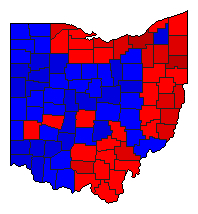Quinnipiac University released several swing state polls on Monday that were, on balance, good news for Hillary Clinton. She had leads in Florida, North Carolina, and Pennsylvania—which suggests a fairly comfortable Electoral College win. Yet Donald Trump was shown with a five-percentage point lead in Ohio. This is peculiar because Ohio tends to move in tandem with these other swing states. And the Quinnipiac poll is hardly an outlier. In the last eight surveys of the Buckeye State that Real Clear Politics has compiled, Clinton has only led in one of them.
To figure out what’s happening in Ohio, it’s best to start with a little history. It used to be that when Democrats won the state of Ohio, their coalition looked like an inverted “C.” Consider, for instance, the map in 1996. The following is courtesy of Dave Leip’s Atlas of U.S. Presidential Elections, a crucial resource for any student of election results. Counties that went for Bill Clinton are in red, those that went for Bob Dole are in blue (this is reverse of today’s conventional designation, but it used to be that the GOP was the “blue” party).

The base Democratic coalition was the string of industrial towns that run from Toledo to Cleveland, southeast past Akron, into the Mahoning Valley along the Ohio-Pennsylvania border, and finally into Appalachian Ohio in the rural, southern portion of the state. Along the way, Clinton picked up wins in Columbus and Akron—enough for a solid, six-point win. Dole carried the historically Republican northwest, as well as Cincinnati and its suburbs, and metro Columbus.
In 2012, President Obama’s share of the nationwide two-party vote (52.0 percent) was three points slimmer than Clinton’s in 1996 (54.7 percent), and Ohio narrowed, as well. Check out the counties that fell into Romney’s column.

Obama held the old industrial counties along Lake Erie, swung Cincinnati, and generally held the line around Cleveland. But Romney held his own along the Pennsylvania border, and almost swept Appalachian Ohio. The map does not really show it, but Obama’s percentage margin in Dayton was about half of what Clinton won in 1996.
This is a signal that the white working class, which for generations had been the backbone of the Ohio Democratic party, is starting to slip from the party’s grasp. Obama made up for it with an enormous haul in Columbus, holding firm in Cleveland, and flipping Cincinnati, but on balance this suggests room for GOP improvement.
Why is this happening? Ohio was the beating heart of the Midwest’s industrial revolution. The 19th century Republican party was anchored in Ohio, and it is no coincidence that the party’s economic program revolved around tariff protection. With the rapid expansion of industrial unions in the middle of the 20th century, Ohio’s working class jumped to the Democratic party. Deindustrialization has since sapped the old unions of their once formidable political clout, and the Democrats have increasingly become a coalition of upscale, socially liberal whites and nonwhites—hardly appealing to Ohio’s white working class. That Mitt Romney—the multimillionaire former governor of Massachusetts and certainly no protectionist—could snag so many of these voters is a sign of their alienation from their old party.
Enter Trump. For a certain class of Republican voter, his proclamation that tariffs can reverse American decline sounds like nails on a chalkboard, but it resonates with these voters. That Trump is doing well here while trailing in the other crucial swing states is therefore a reminder that the white working class in Ohio remains a potent political force. Indeed, if Trump is underperforming Romney among upscale suburbanites in Cincinnati and Columbus, he must be doing that much better in Youngstown, Dayton, Akron, and other small, industrial towns. The Quinnipiac University poll released earlier this week found Trump leading Hillary Clinton by 12 points among whites without a college degree. If this number holds, Trump should win the state pretty handily.
